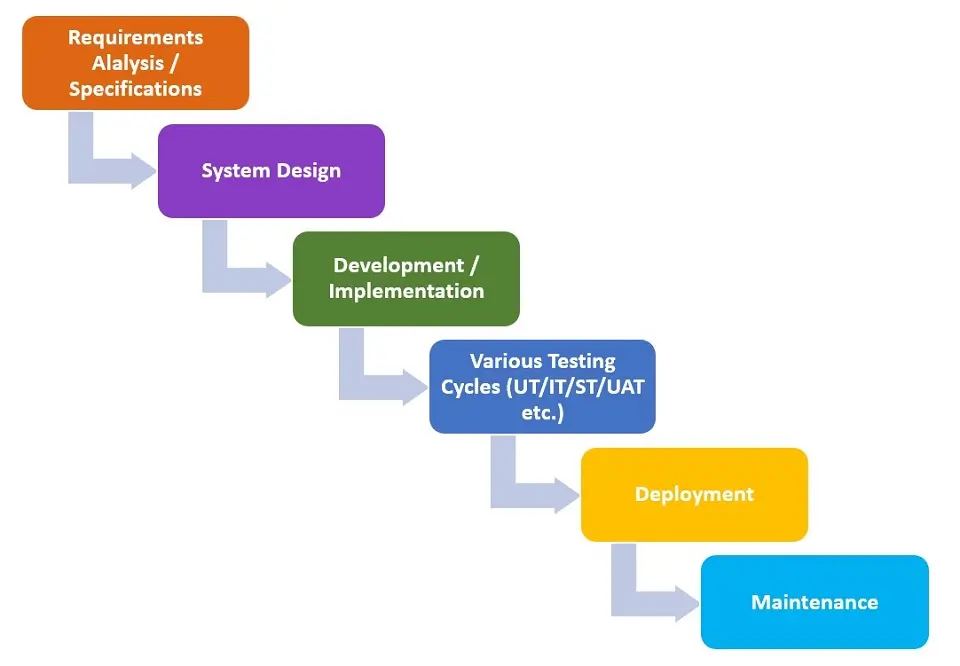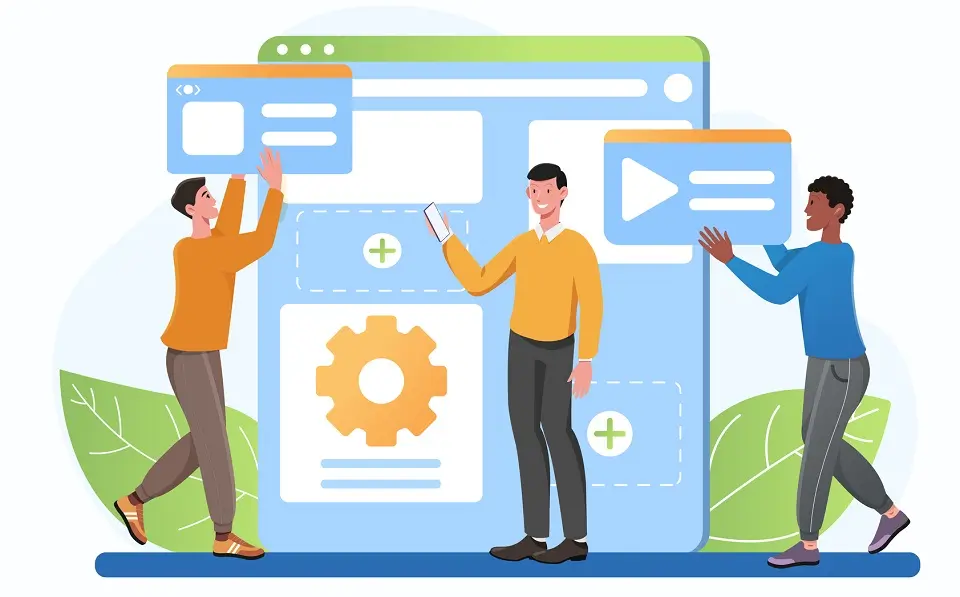The Waterfall Methodology for Software Development Project Management

Before Agile, the traditional Waterfall Methodology was once known as the gold standard for software development. The method was initially defined in 1970 by Winston W. Royce.
Requirement-Gathering Phase


The Waterfall method starts with the Requirements-gathering phase, where a lot of communication occurs upfront to ensure defining the requirements. For example, the Project Manager will get a detailed understanding of the user’s requirements.
- Challenges: Understanding user needs accurately; avoiding scope creep.
- Best Practices: Use of detailed questionnaires, stakeholder interviews, and feedback sessions.
- Tools & Techniques: Requirements management tools, flowcharts, and use-case diagrams.
Design Phase


The next phase is the Design phase. The design phase has two sub-phases as follows:
- Functional design
- Technical specifications design
The above two are also referred to as Logical and Physical Design. The Functional or Logical Design is in the hands of the analysts who use the information from the Requirements phase to design the system. They then transform the system into Technical specifications or Physical Design.
- Challenges: Balancing user requirements with technical feasibility.
- Best Practices: Prototyping, peer reviews, and design validation.
- Tools & Techniques: Design modeling tools, wireframing, and architectural diagrams.
Development Phase


The next stage is about writing the code in case of development projects or customization in case of software package Implementation projects (such as SAP, Oracle EBS, Guidewire, etc.). Again, the programmers or the Customization team will take control in this phase, taking and understanding the project requirements and specifications to create the code for the application.
- Challenges: Adhering to specifications; managing technical debt.
- Best Practices: Code reviews, continuous integration, and modular development.
- Tools & Techniques: Integrated development environments (IDEs), and version control systems.
Testing Phase


Ensuring that the development has gone through the Verification or testing (quality assurance) phases is essential. Please note that though the above diagram shows different testing phases clubbed together in one box, such is not the case. Various test cycles like Unit Testing, Integration Testing, System Testing, User Acceptance Testing, etc., are carried out to ensure the project meets customer expectations.
- Challenges: Identifying and fixing defects and ensuring test coverage.
- Best Practices: Automated testing, test-driven development, and regression testing.
- Tools & Techniques: Test automation tools and bug-tracking systems.
Maintenance Phase


The last phase is Maintenance, and in this stage, the customer interacts with the developed application. This is an ongoing phase till the software remains in use. This phase takes care of bug fixing or implementation of any changes in the requirements and system enhancements, etc. In the case of the packaged software, this phase covers version upgrades also.
- Challenges: Efficiently handling bugs and new feature requests.
- Best Practices: Regular updates, user feedback loops, and proactive maintenance.
- Tools & Techniques: Ticketing systems and performance monitoring tools.
Adaptations and Variations of the Waterfall Model
The Waterfall model, while effective in certain scenarios, has faced criticism for its rigidity and lack of flexibility. To address these limitations, several adaptations and variations have been developed:
- Modified Waterfall Model: Incorporates feedback loops allowing for minor revisions to previous phases. This approach acknowledges the need for revisiting and revising stages based on new information or changes.
- Sashimi Model (Waterfall with Overlapping Phases): This methodology allows for slight overlaps between phases. For instance, the design phase can start before the complete finalization of the requirements phase, facilitating a more fluid transition between stages.
- Agile-Waterfall Hybrid: Combines the structured approach of Waterfall with the flexibility of Agile methodologies. In this model, planning and requirements gathering are in a Waterfall manner. However, development and implementation are with Agile practices, allowing for iterative testing and refinement.
- V-Model (Validation and Verification Model): An extension of the Waterfall model, where each development stage is directly associated with a testing phase. This model emphasizes verification and validation parallel to each stage of development, enhancing quality control.
- Incremental Waterfall Model: Divides the project into smaller segments, each following the Waterfall phases. This allows for portions of the project to be delivered incrementally, facilitating earlier testing and feedback.
These adaptations are to combine the clear structure and ease of management of the traditional Waterfall model with greater flexibility and responsiveness to change, making them suitable for a wider range of projects and dynamic environments.
Pros and Cons of Waterfall Methodology
Like everything, waterfall project management methodology also has its pros and cons. Let’s have a look at the advantages and disadvantages of executing projects with the waterfall methodology:
Pros of Waterfall Project Management:
- Simple and Easy to Understand: The linear approach makes the process straightforward, which is particularly beneficial for new team members or when working with clients who prefer a clear, structured approach.
- Well-Defined Stages: Each phase has specific deliverables and a review process. This makes in easier to understand the requirements of the concerned phase.
- Emphasis on Documentation: Due to the structured nature of the methodology, it requires thorough documentation at each stage. This can be useful for maintaining a clear record of the project’s progress and for future reference.
- Easy to Manage: Since each phase must be completed before the next begins, it’s easier to manage timelines, resources, and budgets.
- Predictable Outcomes: The upfront planning and design mean that outcomes are more predictable, assuming that the project teams understand the initial requirements well and the requirements do not undergo frequent changes.
Cons of Waterfall Project Management:
- Inflexibility: After we complete one stage, it’s difficult to go back and make changes. This can be problematic if the project requirements change or if unforeseen issues arise.
- Late Testing and Integration: Testing is often left until after the build phase. This can lead to the discovery of major issues late in the project, causing delays and cost overruns.
- Poor Adaptability to Change: Waterfall methodology does not suit well for projects where requirements are likely to change or are not well understood at the outset.
- Delayed Delivery: The product is only tested and delivered at the end of the cycle. This can delay feedback and prolong the time before the end product is available.
- Risk of Misalignment with User Needs: Since there’s limited user involvement during the development stages, there’s a risk that the final product may not fully meet the user’s needs or expectations.
- Higher Risk and Uncertainty: In case of any mistakes or misjudgments in the initial phases, it can be costly and time-consuming to rectify later in the project.
Future Outlook of the Waterfall Model
The future of the Waterfall model in project management is shaped by evolving industry trends and the increasing need for flexibility in project execution. Despite its perceived rigidity, Waterfall remains relevant in contexts where requirements are clear and unlikely to change, such as in certain types of construction and manufacturing projects.
However, the rise of dynamic market conditions and the need for rapid adaptation suggest a shift towards more flexible, iterative methodologies like Agile. In response, we can expect further integrations of Waterfall with Agile practices, creating hybrid models that balance structured planning with adaptability.
The increasing influence of AI and machine learning in project management also presents an opportunity for enhancing the Waterfall model. These technologies could aid in better risk assessment, more accurate requirement analysis, and efficient resource management, potentially mitigating some of the traditional limitations of Waterfall.
In summary, while the Waterfall model may see reduced dominance in fields like software development, its core principles will continue to influence project management practices. Its future lies in adaptation and integration with other methodologies and technologies, catering to the diverse needs of various industries.
Conclusion
The Waterfall model can be highly effective for projects with very clear, stable requirements and where a linear approach is advantageous. However, its lack of flexibility can make it less suitable for more dynamic or complex projects where requirements may evolve.


Nisha Arya is a Data Scientist and Technical writer from London.
Having worked in the world of Data Science, she is particularly interested in providing Data Science career advice or tutorials and theory-based knowledge around Data Science. She is a keen learner seeking to broaden her tech knowledge and writing skills while helping guide others.

